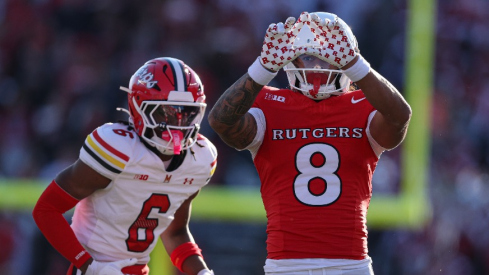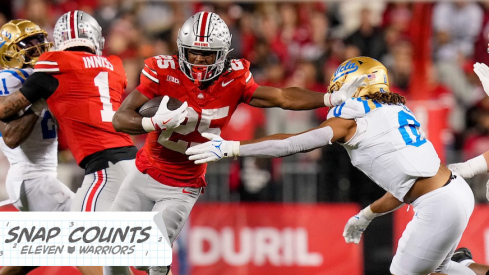
For many teams the offense gets the glamour and awards. But that is not the case for Nick Saban's Alabama Crimson Tide. During a time when offenses have set records when increasingly alacrity, Saban's Crimson Tide have stood atop the college football landscape based upon an often-dominant defense. A week after examining Alabama's offense, I turn to the defending national champion's defense.
Exception(al)
Saban's defense is one of the few in college football that bases out of a 3-4 defense. The primary difference between a 3-4 and 4-3 difference is that with the 3-4 a defensive linemen--generally the nose guard--is responsible for two gaps. The nose guard will line directly over the center and seek to defend both gaps by neutralizing the center and making a pile. This creates freedom to use the linebackers in creative ways. In a 4-3, by contrast, each defensive lineman and linebacker is responsible for one gap.

Saban is not wedded to the 3-4, however. He will instead also utilize four man, one gap fronts, such as the 4-3 under above. Saban and his defensive coordinator Kirby Smart also use four man fronts when they go to their his sub, or nickel, package. Alabama uses nickel looks quite often, given the frequency with which they face spread offenses in modern college football.
Making his Mark
Saban's defensive fronts therefore employ an aggressive yet flexible framework. But where Saban has made his most lasting schematic mark upon football is his implementation of man pattern matching principles within zone coverages. At its simplest, pattern matching simply means that each zone defender will play man defense within his zone. Before the snap, the defense will identify the number 1, 2, and 3 receivers to each side (from outside to in). Upon the snap, the defenders will drop to their designated zone. If the receivers all run vertical routes the defenders simply will play man coverage, with the cornerback taking number 1, safety number 2, etc. If the number 1 receiver breaks inside, however, the assignment changes. The corner will not follow, as in traditional man, but will instead pass that receiver off to the inside zone defender and wait. Knowing how most pass patterns are distributed, it is likely that an inside receiver will eventually come into that cornerback's zone. Similarly, the inside defenders will wall off any quick routes, and then pick up the incoming crossing route. (H/T: Chris Brown). The safety and outside linebackers will work in tandem The safety will generally take any inside routes longer than 8 yards, while the linebackers are responsible for short inside routes underneath. The linebackers will also widen with flat routes if no underneath inside routes show.

As Chris Brown states, in short, the coverage looks like man when the defenders release deep, and zone when they cross. The defense is made possible, above all, by recognition. Saban drills with his defensive backs what typical pass pattern combinations look like, and who is likely to appear in their zone when another receiver vacates.
Trial and Error
As the old saying goes, invention is the mother of necessity. Saban and his colleague Bill Belicheck came to pattern-matching because they were getting beat. Saban and Belicheck traditionally based out of single high safety coverages such as cover-3. NFL offenses began gaining yards, however, by running four vertical pass patterns from the one-back offense. As Saban states (courtesy of Brophy):
When you’re playing a passing team you always have a better chance with split-safeties, but with all this zone read / zone option stuff we see…all the spread stuff, sometimes you’ve got to be able to play middle-of-the-field coverage to get an extra guy in the box.
We got to the point where, this is the reason that we do this, when everybody started going spread we couldn’t play 3 deep zone. This started with the Cleveland Browns, I was the defensive coordinator in the early 90s and Pittsburgh would run 'Seattle' on us , four streaks. Then they would run two streaks and two out routes, what I call ‘pole’ route from 2x2. So we got to where could NOT play 3-deep zone because we rerouted the seams and played zone, and what I call “Country Cover 3” (drop to your spot reroute the seams, break on the ball). Well , when Marino is throwing it, that old break on the ball shit don’t work.
So because we could not defend this, we could not play 3 deep, so when you can’t play zone, what do you do next? You play Man (cover 1), but if their mens are better than your mens, you can’t play cover 1 .
We got to where we couldn’t run cover 1 - So now we can’t play an 8 man front.
The 1994 Browns went 13-5 , we lost to Steelers 3 times, lost 5 games total (twice in the regular season, once in the playoffs). We gave up the 5th fewest points in the history of the NFL, and lost to Steelers because we could not play 8-man fronts to stop the run because they would wear us out throwing it
We came up with this concept; how we can play cover 1 and cover 3 at the same time, so we can do both these things and one thing would complement the other. We came up with the concept “rip/liz match”.
In essence, the Rip/Liz call announces that with four vertical routes, the safety coming down will be responsible for the No. 2 receiver to one side and the outside linebacker will play the seam opposite the safety. Their goal is to maintain inside leverage, making the receivers re-route so that the deep free safety has time to make a play on the football. Saban prefers the 3-4 because it provides him two detached linebackers to each side that can easily adjust to fill this role. This is but one form of Saban's pattern matching. He will use this coverage style from any coverage. For example, with cover 4, the defense works in a similar matter. As Brophy states:
With two receivers to the passing strength, you have the vertical stem of #2 being controlled by the deep safety, and any vertical by #1 being handled by the corner (unless in “MEG”). The SLB / Nickel will take the first receiver to the flat, the Mike will match the final #3.

Pattern matching provides Saban the opportunity to be extremely versatile and yet use the same framework for any coverage. The defense can base from a two-high shell, quickly drop down to a one-high defense to play the run and still deal with four deep receivers. The defense can play even safety defenses using the same principles, and is well practiced in man coverage. The secondary adjust to any offensive alignment such as trips. Players get ample practice repetitions under the same framework.
Saban's system also has the benefit of putting athletic, intelligent players in a position to make plays and succeed. This complicated, yet simple system is the backbone of Alabama's success.

